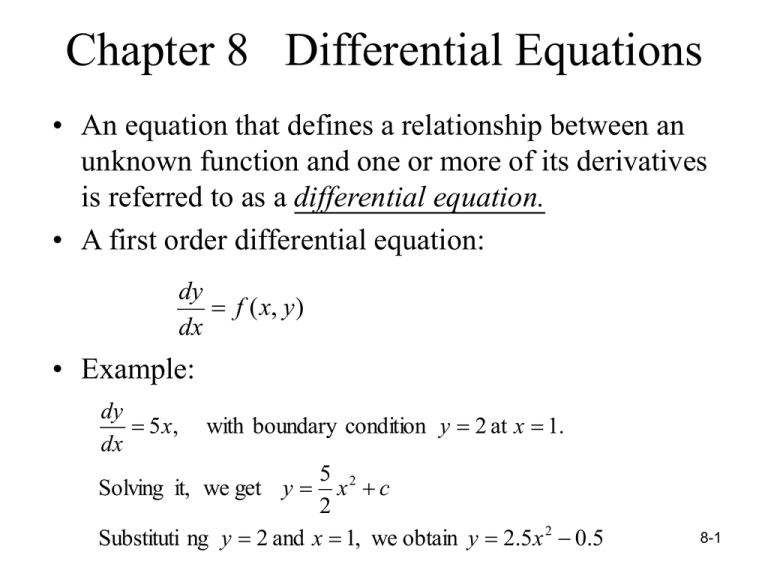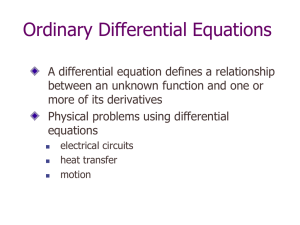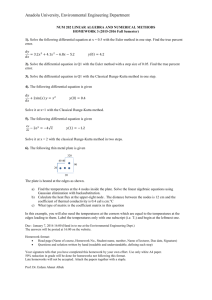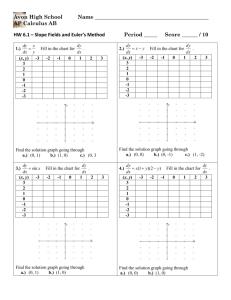chap8
advertisement

Chapter 8 Differential Equations • An equation that defines a relationship between an unknown function and one or more of its derivatives is referred to as a differential equation. • A first order differential equation: dy f ( x, y ) dx • Example: dy 5 x, dx with boundary condition y 2 at x 1. 5 2 Solving it, we get y x c 2 Substituti ng y 2 and x 1, we obtain y 2.5 x 2 0.5 8-1 • Example: dy c( y x) dx • A second-order differential equation: d2y dy f ( x, y , ) 2 dx dx • Example: y ' ' 2 x xy y ' 8-2 Taylor Series Expansion • Fundamental case, the first-order ordinary differential equation: dy f ( x) dx subject to y y0 at x x0 Integrate both sides y y0 x dy f ( x )dx x0 x or y g ( x ) y0 f ( x )dx x0 • The solution based on Taylor series expansion: ( x x0 )2 y g ( x ) g ( x0 ) ( x x0 ) g ' ( x ) g ' ' ( x0 ) ... 2! where y0 g ( x0 ) and g ' ( x0 ) f ( x0 ) 8-3 Example : First-order Differential Equation Given the following differential equation: dy 3 x 2 such that y 1 at x 1 dx The higher-order derivatives: d2y 6x 2 dx d3y 6 3 dx dny 0 for n 4 n dx 8-4 The final solution: dy ( x 1)2 d 2 y ( x 1)3 d 3 y g ( x ) 1 ( x 1) 2 dx 2! dx 3! dx 3 ( x 1) 2 ( x 1)3 2 1 ( x 1)( 3x0 ) (6 x0 ) (6) 2! 3! 1 3( x 1) 3( x 1)2 ( x 1)3 where x0 1 8-5 Table: Taylor Series Solution x One Term Two Terms Three Terms Four Terms 1 1 1 1 1 1.1 1 1.3 1.33 1.331 1.2 1 1.6 0.72 1.728 1.3 1 1.9 2.17 2.197 1.4 1 2.2 2.68 2.744 1.5 1 2.5 3.25 3.375 1.6 1 2.8 3.88 4.096 1.7 1 3.1 4.57 4.913 1.8 1 3.4 5.32 5.832 1.9 1 3.7 6.13 6.859 2 1 4 7 8 8-6 8-7 General Case • The general form of the first-order ordinary differential equation: dy f ( x, y ) dx subject to y y0 at x x0 • The solution based on Taylor series expansion: y g ( x ) g ( x0 , y0 ) ( x x0 ) g ' ( x0 , y0 ) ( x x0 ) g ' ' ( x0 , y0 ) ... 2! 8-8 Euler’s Method • Only the term with the first derivative is used: dy g ( x) g ( x0 ) ( x x0 ) e dx • This method is sometimes referred to as the one-step Euler’s method, since it is performed one step at a time. 8-9 Example: One-step Euler’s Method • Consider the differential equation: dy 4 x 2 such that y 1 at x 1 dx • For x =1.1 y 1 1.1 dy 4 x 2 dx 1 4 3 1.1 y 1 x 0.44133 1 3 Therefore, at x=1.1, y=1.44133 (true value). 8-10 With a step size of x ( x x0 ) 0.1, we get g (1.1) 1 0.1[4(1) 2 ] 1.4 The error 0.04133 (in absolute value). Use a step size of 0.05 and apply Eule r' s equation twice (at x 1 and x 1.05) : g (1.05) g (1) (1.05 1.00)[ 4(1) 2 ] 1 0.2 1.2 g (1.10) g (1.05) (1.10 1.05)[ 4(1.05) 2 ] 1.4205 The error is reduced to 0.020833. For a step size of 0.02, after five steps, the estimated value g(1.10) 1.43296 The error is 0.008373. 8-11 Errors with Euler`s Method • Local error: over one step size. Global error: cumulative over the range of the solution. • The error using Euler`s method can be approximated using the second term of the Taylor series expansion as ( x x0 )2 d 2 y 2! dx 2 d2y where is the maximum in [ x0 , x ]. 2 dx • If the range is divided into n increments, then the error at the end of range for x would be n. 8-12 Example: Analysis of Errors dy 4 x 2 such that y 1 at x 1 dx d2y 8x 2 dx ( x x0 )2 Thus, the error is bounded by (8 x ) 4 x ( x x0 )2 2! For step sizes of 0.1, 0.05, and 0.02. the upper limits on the error at x 1.1 : 0.1 4(1.1)( 0.1)2 0.044 0.05 2(4)(1.1)( 0.05)2 0.022 0.02 5(4)(1.1)( 0.02)2 0.0088 8-13 Table: Local and Global Errors with a Step Size of 0.1. x 1 Exact solution Numerical Solution Local Error(%) Global Error(%) 1 1 0 0 1.1 1.4413333 1.4 -2.8677151 -2.8677151 1.2 1.9706667 1.884 -2.300406 -4.3978349 1.3 2.596 2.46 -1.9003595 -5.238829 1.4 3.3253333 3.136 -1.6038492 -5.6936648 1.5 4.1666667 3.92 -1.396 -5-92 1.6 5.128 4.82 -1.1960478 -6.0062402 1.7 6.2173333 5.844 -1.0508256 -6.004718 1.8 7.4426667 7 -0.9315657 -5.947689 1.9 8.812 8.296 -0.8321985 -5.8556514 10.333333 9.74 -0.7483871 -5.7419355 2 8-14 Table: Local and Global Errors with a Step Size of 0.05. x Exact solution Numerical Solution Local Error(%) Global Error(%) 1 1 1 0 0 1.05 1.2101667 1.2 -0.8401047 -0.8401047 1.1 1.4413333 1.4205 -0.7400555 -1.4454209 1.15 1.6945 1.6625 -0.6589948 -1.8884627 1.2 1.9706667 1.927 -0.5920162 -2.2158322 1.25 2.2708333 2.215 -0.5357798 -2.4587156 1.3 2.596 2.5275 -0.4879301 -2.6386749 1.35 2.9471667 2.8655 -0.4467568 -2.771023 1.4 3.3253333 3.23 -0.4109864 -2.8668805 1.45 3.7315 3.622 -0.3796507 -2.9344768 1.5 4.1666667 4.4025 -0.352 -2.98 8-15 Table: Local and Global Errors with a Step Size of 0.05 (continued). x Exact solution 1.55 4.6318333 1.6 Numerica l Solution Local Error(%) Global Error(%) 4.4925 -0.3274441 -3.0081681 5.128 4.973 -0.3055122 -3.0226209 1.65 5.6561667 5.485 -0.2858237 -3.0261956 1.7 6.2173333 6.0295 -0.2680678 -3.0211237 1.75 6.8125 6.6075 -0.2519878 -3.0091743 1.8 7.4426667 7.22 -0.2373701 -2.9917592 1.85 8.1088333 7.868 -0.2240355 -2.9700121 1.9 8.812 8.5525 -0.2118323 -2.9448479 1.95 9.5531667 9.2745 -0.2006316 -2.9170083 2 10.333333 10.035 -0.1903226 -2.8870968 8-16 Table: Local and Global Errors with a Step Size of 0.02. x Exact solution Numerical Solution Local Error(%) Global Error(%) 1 1 1 0 0 1.02 1.0816107 1.08 -0.1489137 -0.1489137 1.04 1.1664853 1.163232 -0.1408219 -0.2789005 1.06 1.254688 1.24976 -0.1334728 -0.392767 1.08 1.3462827 1.339648 -0.1267688 -0.4928138 1.1 1.4413333 1.43296 -0.120629 -0.5809436 1.2 1.9706667 1.95312 -0.0963464 -0.8903924 1.3 2.596 2.56848 -0.0793015 -1.0600924 1.4 3.3253333 3.28704 -0.0667201 -1.1515638 1.5 4.1666667 4.1168 -0.057088 -1.1968 1.6 5.128 5.06876 -0.049506 -1.2137285 1.7 6.2173333 6.14192 -0.0434055 -1.212953 1.8 7.4426667 7.35328 -0.0384092 -1.2010032 1.9 8.812 8.70784 -0.0342563 -1.1820245 2 10.333333 10.2136 -0.0307613 -1.1587097 8-17 Modified Euler’s Method • Use an average slope, rather than the slope at the start of the interval : a. Evaluate the slope at the start of the interval b. Estimate the value of the dependent variable y at the end of the interval using the Euler’s metod. c. Evaluate the slope at the end of the interval. d. Find the average slope using the slopes in a and c. e. Compute a revised value of the dependent variable y at the end of the interval using the average slope of step d with Euler’s method. 8-18 Example : Modified Euler’s Method dy x y dx such that y 1 at x 1 The five steps of the first iteration for x 0.1 : 1a. dy 1 1 1 dx 1 1b. g (1.1) g (1.0) (1.1 1.0) 1c. dy 1 0.1(1) 1.1 dx 1 dy 1.1 1.1 1.15369 dx 1.1 dy 1 1d. (1 1.15369) 1.07684 dx a 2 1e. g (1.1) g (1.0) (1.1 1.0) dy 1 0.1(1.07684) 1.10768 dx a 8-19 The steps for the second interval : dy 2a. x y 1.1 1.10768 1.15771 dx 1.1 dy 2b. g (1.2) g (1.1) (1.2 1.1) 1.10768 0.1(1.15771) 1.22345 dx 1.1 dy 2c. 1.2 1.22345 1.32732 dx 1.2 dx 1 dx dx 2d. ( ) 1.24251 dy a 2 dy 1.1 dy 1.2 dy 2e. g (1.2) g (1.1) (1.2 1.1) 1.23193 dx a 8-20 Second-order Runge-Kutta Methods • The modified Euler’s method is a case of the secondorder Runge-Kutta methods. It can be expressed as yi 1 yi 0.5[ f ( xi , yi ) f ( xi h, yi hf ( xi , yi ))]h where yi g ( xi ), yi 1 g ( xi x ), xi 1 xi x, h x 8-21 • The computations according to Euler’s method: 1. Evaluate the slope at the start of an interval, that is, at (xi,yi) . S1 f ( xi , yi ) 2. Evaluate the slope at the end of the interval (xi+1,yi+1) : S2 f ( xi h, yi hS1 ) 3. Evaluate yi+1 using the average slope S1 of and S2 : yi 1 yi 0.5( S1 S2 )h 8-22 Third-order Runge-Kutta Methods • The following is an example of the third-order RungeKutta methods : 1 yi 1 yi [ f ( xi , yi ) 4 f ( xi 0.5h, yi 0.5hf ( xi , yi )) 6 f ( xi h, yi hf ( xi , yi ) 2hf ( xi 0.5h, yi 0.5hf ( xi , yi )))]h 8-23 • The computational steps for the third-order method: 1. Evaluate the slope at (xi,yi). S1 f ( xi , yi ) 2. Evaluate a second slope S2 estimate at the mid-point in of the step as S 2 f ( xi 0.5h, yi 0.5hS1 ) 3. Evaluate a third slope S3 as S3 f ( xi h, yi hS1 2hS2 ) 4. Estimate the quantity of interest yi+1 as 1 yi 1 yi [ S1 4 S 2 S3 ]h 6 8-24 Fourth-order Runge-Kutta Methods dy f ( x, y ) such that y y0 at x x0 dx x h. 1. Compute the slope S1 at (xi,yi). S1 f ( xi , yi ) 2. Estimate y at the mid-point of the interval. yi 1/ 2 yi h f ( xi , yi ) 2 3. Estimate the slope S2 at mid-interval. S 2 f ( xi 0.5h, yi 0.5hS1 ) 4. Revise the estimate of y at mid-interval yi 1 / 2 yi h S2 2 8-25 5. Compute a revised estimate of the slope S3 at midinterval. S3 f ( xi 0.5h, yi 0.5hS 2 ) 6. Estimate y at the end of the interval. yi 1 yi hS3 7. Estimate the slope S4 at the end of the interval S4 f ( xi h, yi hS3 ) 8. Estimate yi+1 again. h yi 1 yi ( S1 2 S2 2 S3 S4 ) 6 8-26 Predictor-Corrector Methods • Unless the step sizes are small, Euler’s method and Runge-Kutta may not yield precise solutions. • The Predictor-Corrector Methods iterate several times over the same interval until the solution converges to within an acceptable tolerance. • Two parts: predictor part and corrector part. 8-27 Euler-trapezoidal Method • • • • Euler’s method is the predictor algorithm. The trapezoidal rule is the corrector equation. Eluer formula (predictor): dy yi 1, j yi ,* h dx i ,* Trapezoidal rule (corrector): h dy dy yi 1, j yi ,* [ ] 2 dx i ,* dx i 1, j 1 The corrector equation can be applied as many times as necessary to get convergence. 8-28 Example 8-6: Euler-trapezoidal Mehtod dy Problem : x y such that y 1 at x 1 dx The initial (predictor ) estimate for y at x 1.1 is dy 1 1 1 dx 0,0 y1,0 y1,0 dy y0,* 0.1 dx 0, 0 1 0.1(1) 1.1 The corrector equation is used to improve the estimate : dy 1.1 1.1 1.15369 dx 1,0 8-29 h dy dy 0.1 1 1.15369 1.10768 y1,1 y0,* 1 2 dx 0,0 dx 1,0 2 dy dx 1,1 y1, 2 h dy dy 0. 1 1 1.15771 1.10789 y0,* 1 2 dx 0,0 dx 1,1 2 dy dx 1, 2 1.1 1.10768 1.15771 1.1 1.10789 1.15782 h dy dy 0.1 1 1.15782 1.10789 y1,3 y0,* 1 2 dx 0,0 dx 1, 2 2 Since y1,3 y1, 2 , y converges to 1.10789 at x 1.1. And we have y1,* y1,3. 8-30 For the estimate of y at x 1.2, the predictor equation : dy y2,0 y1,* h 1,* 1.10789 0.1(1.15782) 1.22367 dx The corrector equation : dy 1.2 1.22367 1.32744 dx 2,1 h dy dy y2,1 y1,* 2 dx 1,* dx 2,1 1.10789 0.1 1.15782 1.32744 1.23215 2 dy 1.2 1.23215 1.33203 dx 2, 2 8-31 y2 , 2 h dy dy y1,* 2 dx 1,* dx 2, 2 0.1 1.15782 1.33203 1.23238 1.10789 2 dy 1.2 1.23238 1.33215 dx 2,3 h dy dy y2,3 y1,* 2 dx 1,* dx 2,3 0.1 1.15782 1.33215 1.23239 1.10789 2 Again, the corrector algorithm converges in three iterations . The estimate of y at x 1.2 is 1.23239. 8-32 Milne-Simpson Method • • • Milne’s equation is the predictor euqation. The Simpson’s rule is the corrector formula. Milne’s equation (predictor): yi 1,0 yi 3,* • 4h dy dy dy [2 2 ] 3 dx i ,* dx i 1,* dx i 2,* For the two initial sampling points, a one-step method such as Euler’s equation can be used. Simpsos’s rule (corrector): h dy dy dy yi 1, j yi 1,* [ 4 ] 3 dx i 1, j dx i ,* dx i 1,* 8-33 Example 8-7: Milne-Simpson Mehtod Problem : dy x y such that y 1 at x 1 dx We want to estimate y at x 1.3 and x 1.4. Assume that we have the following values, obtained from the Euler-trapezoidal method in Example 8-6. dy dx x y 1 1 1 1.1 1.10789 1.15782 1.2 1.23239 1.33215 8-34 To compute the initial (predictor ) estimate for y at x 1.3 , Euler' s method can be used : y3,0 dy y2,* h 1.23239 0.1(1.33215) 1.36560 dx 2,* dy 1.3 1.36560 1.51917 dx 3,0 The corrector formular : 0.1 dy dy dy y3,1 y1,* 4 3 dx 3,0 dx 2,* dx 1,* 0.1 1.51917 4(1.33215) 1.15782 1.10789 3 1.37474 8-35 dy 1.3 1.37474 1.52424 dx 3,1 0.1 y3,2 1.10789 1.52424 4(1.33215) 1.15782 3 1.37491 dy 1.3 1.37491 1.52434 dx 3,2 0.1 y3,3 1.10789 1.52434 4(1.33215) 1.15782 3 1.37492 The computations for x=1.3 are complete. 8-36 The Milne predictor equation for estimating y at x=1.4: y4 , 0 4h dy dy dy y0,* 2 2 3 dx 3,* dx 2,* dx 1,* 40.1 21.52434 1.33215 21.15782 1 3 1.53762 The corrector formular: dy 1.4 1.53762 1.73610 dx 4,1 8-37 h dy dy dy y4,1 y2,* 4 3 dx 4,0 dx 3,* dx 2,* 1.23239 0.1 1.73601 41.52434 1.33215 3 1.53791 dy 1.4 1.53791 1.73617 dx 4, 2 0.1 1.73617 41.52434 1.33215 1.53791 3 Then it is complete. y4, 2 1.23239 8-38 Least-Squares Method • The procedure for deriving the least-squares function: 1. Assume the solution is an nth-order polynomial: yˆ b0 b1x b2 x 2 bn x n 2. Use the boundary condition of the ordinary differential equation to evaluate one of (bo,b1,b2,…,bn). 3. Define the objective function: F e 2 dx x dyˆ dy where e dx dx 8-39 4. Find the minimum of F with respect to the unknowns (b1,b2, b3,…,bn) , that is F e 2e dx 0 all x bi bi 5. The integrals in Step 4 are called the normal equations; the solution of the normal equations yields value of the unknowns (b1,b2, b3,…,bn). 8-40 Example 8-8: Least-squares Method Problem : dy xy such that y 1 at x 0 dx Solve it for the interval 0 x 1. Analytical solution : y e x2 / 2 • First, assume a linear model is used: yˆ b0 b1 x Using the boundary condition yˆ 1 b0 b1 (0) yields b0 1. Thus the linear model is yˆ 1 b1 x dyˆ b1 dx 8-41 The error function : e b1 xy b1 x (1 b1 x ) de 1 x2 db1 x 0 x de 2e dx 2[b1 x (1 b1 x )](1 x 2 )dx 0 0 db1 2 3 4 5 x x 2b1 x x b1 x (b1 x ) 0 2 3 4 5 0 Since we are interested in the range 0 x 1, solve the above integral with x 1, we get b1 15 . Thus, 32 yˆ 1 15 32 x 8-42 Table: A linear model for the least-squares method x True y Value ye x2 / 2 Numerical y Value Error (%) yˆ 1 15 32 x 0 1. 1. - 0.2 1.0202 1.0938 7.2 0.4 1.0833 1.1875 9.6 0.6 1.1972 1.2812 7.0 0.8 1.3771 1.3750 0.0 1.0 1.6487 1.46688 -10.9 8-43 • Next, to improve the accuracy of estimates, a quadratic model is used: yˆ b0 b1 x b2 x 2 Using the boundary condition yˆ 1 b0 b1 (0) b2 (02 ) yields b0 1. dyˆ b1 2b2 x dx The error function is e b1 2b2 x xy b1 2b2 x x (1 b1 x b2 x 2 ) b1 (1 x 2 ) b2 ( 2 x x 3 ) x 8-44 e 1 x2 b1 b 1 x b 2 x x x 1 x dx 0 x 0 2 3 1 2 2 x 2b1 x 3b2 x x b1 x b2 x x 2 b x b x 0 2 1 3 4 2 5 6 4 0 Using x 1 as the upper limit : 8b1 5b2 1 15 12 4 3 4 2 5 6 4 8-45 e 2 x x3 b2 2 b1 1 x 2 b2 2 x x 3 x 2 x x 3 dx 0 x 0 x 2 2b1 x 4b2 x 4b2 x 2 x b1 x b2 x x b1 x 4 3 5 3 5 7 5 0 0 Using x 1 as the upper limit : 9b1 71b2 7 20 105 15 We get b1 0.14669 and b2 0.78776. 4 4 5 2 5 7 5 yˆ 1 0.14669 x 0.78776 x 2 8-46 Table: A quadratic model for the least-squares method x True y Value ye x2 / 2 Numerical y Value Error (%) yˆ 1 0.14669 x 0.78776 x 2 0 1. 1. - 0.2 1.0202 1.0022 -1.8 0.4 1.0833 1.0674 0.0 0.6 1.1972 1.1956 0.0 0.8 1.3771 1.38668 0.0 1.0 1.6487 1.6411 0.0 8-47 Galerkin Method w edx 0 x i i 1,2...n where wi is a weighti ng factor. e For the least squares method, wi bi • Example: Galerkin Method The same problem as Example 8-8. Use the quadratic approximating equation. Let w1 x and w2 x 2 . 8-48 1 0 1 0 [b1 (1 x 2 ) b2 ( 2 x x 3 ) x ] xdx 0 [b1 (1 x 2 ) b2 ( 2 x x 3 ) x ] x 2dx 0 We get the following normal equations : 1 7 1 b1 b2 12 15 3 2 1 1 b1 b2 15 3 4 The final result : yˆ 1 0.26316 x 0.85526 x 2 8-49 Table: Example for the Galerkin method x True y value ye x2 / 2 Numerical y value yˆ 1 0.26316 x 0.85526 x 2 Error (%) 0 1. 1. -- 0.2 1.0202 0.9816 0.0 0.4 1.0833 1.0316 0.0 0.6 1.1972 1.1500 0.0 0.8 1.3771 1.3368 0.0 1.0 1.6487 1.5921 0.0 8-50 Higher-Order Differential Equations • Second order differential equation: d2y dy f x, y , 2 dx dx Transform it into a system of first-order differential equations. dy2 f ( x, y1 , y2 ) dx dy1 y2 dx where y1 y and y2 dy1 dy dx dx 8-51 • In general, any system of n equations of the following type can be solved using any of the previously discussed methods: dy1 f1 ( x, y1 , y2 ,... yn ) dx dy2 f 2 ( x, y1 , y2 ,... yn ) dx dy3 f 3 ( x, y1 , y2 ,... yn ) dx dyn f n ( x, y1 , y2 ,... yn ) dx 8-52 Example: Second-order Differential Equation Problem : d 2Y M 10 X X 2 2 dX EI EI It can be transfor med into : dZ M 10 X X 2 dX EI EI dY Z dX Assume EI 3600 at X 0, Y 0 and Z 0.02314 Use Euler' s method to solve the following equations : Z i 1 Z i f 2 ( X i , Yi , Z i )h Yi 1 Yi f1 ( X i , Yi , Z i )h 8-53 Table: Second-order Differential Equation Using a Step Size of 0.1 Ft X (ft) dZ dX Z dY dX Y (ft) Exact Z Exact Y (ft) 0 0 -0.0231481 0 -0.0231481 0 0.1 0.000275 -0.0231481 -0.0023148 -0.0231344 -0.0023144 0.2 0.0005444 -0.0231206 -0.0046296 -0.0230933 -0.004626 0.3 0.0008083 -0.0230662 -0.0069417 -0.0230256 -0.0069321 0.4 0.0010667 -0.0229854 -0.0092483 -0.0229319 -0.0092302 0.5 0.0013194 -0.0228787 -0.0115469 -0.0228125 -0.0115177 0.6 0.0015667 -0.0227468 -0.0138347 -0.0226681 -0.0137919 0.7 0.0018083 -0.0225901 -0.0161094 -0.0224994 -0.0160505 0.8 0.0020444 -0.0224093 -0.0183684 -0.0223067 -0.018291 0.9 0.002275 -0.0222048 -0.0206093 -0.0220906 -0.020511 8-54 Table: Second-order Differential Equation Using a Step Size of 0.1 Ft (continued) X (ft) dZ dX Z dY dX Y (ft) Exact Z Exact Y (ft) 1 0.0025 -0.0219773 -0.0228298 -0.0218519 -0.0227083 2 0.0044444 -0.0185565 -0.0434305 -0.0183333 -0.04296663 3 0.0058333 -0.0134412 -0.0298019 -0.0131481 -0.0588194 4 0.0066667 -0.007187 -0.0704998 -0.0068519 -0.0688889 5 0.0069444 -0.0003495 -0.0746352 0.00000000 -0.071228 6 0.0066667 0.0065157 -0.0718747 0.0068519 -0.0688889 7 0.0058333 0.0128532 -0.06244066 0.0131481 -0.0588194 8 0.0044444 0.0181074 -0.0471107 0.0183333 -0.042963 9 0.0025 0.0217227 -0.0272183 0.0278519 -0.0227083 10 0.000000 0.0231435 -0.00466523 0.0231481 0.000000 8-55




